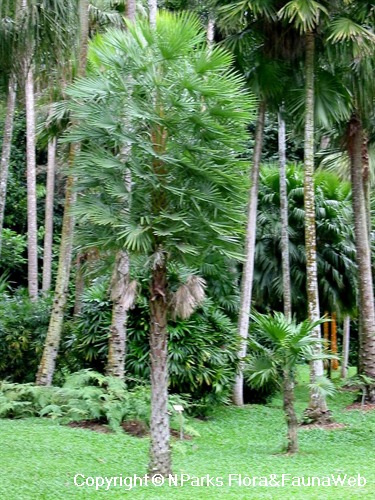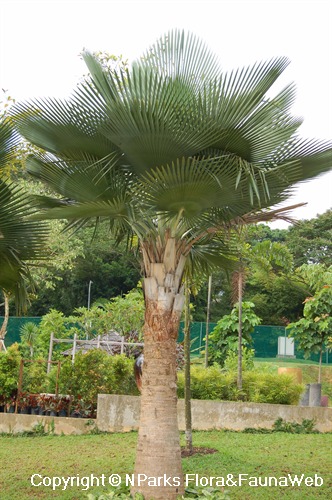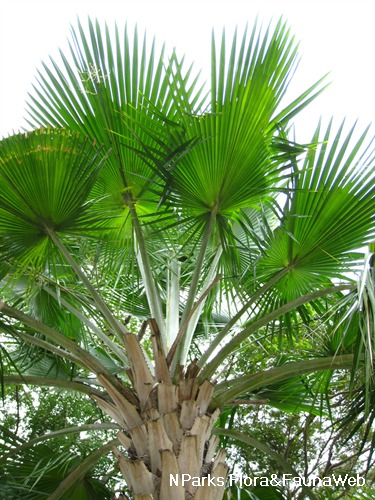
Back
Copernicia alba Morong
| Family Name: | Arecaceae (Palmae) |
| Synonyms: | Copernicia ramulosa,, Copernicia australis var. nigra, Copernicia rubra, Copernicia nigra, Copernicia australis, Copernicia cerifera, Coryphomia tectorum, Copernicia australis var. alba |
| Common Name: | Caranday Palm, Caranda, Palma Blanca, 白巴西蜡棕 |
Name
Classifications and Characteristics
| Plant Division | Angiosperms (Flowering Seed Plants) (Monocotyledon) |
|---|---|
| Plant Growth Form | Palm (Solitary Habit) |
| Mode of Nutrition | Autotrophic |
| Maximum Height | 25 m |
Biogeography
| Native Distribution | South America |
|---|
Description and Ethnobotany
| Growth Form | A handsome, tall, solitary, sturdy palm with clear, orbicularly-palmate green fronds that often forms a dense single-species woodlands in savanna. |
|---|---|
| Trunk | Trunk grey, sturdy, up to 40 cm in diameter, covered with rough old leaf bases (from the base to the first third of its height until the crown of leaves, which is smooth). |
| Foliage | Fronds palmate, orbicular, waxy, green, about 75 to 80 cm across, with 30 to 35 induplicating (having edges or margins folded inward) segments , slightly forked, each 35 cm long and 4 to 5 cm wide. |
| Others - Plant Morphology | Flower: Inflorescences branched, erect, arising from the leaf crown; flowers solitary or grouped, cream; sepals 3; petals 3; stamens 6 (species can be recognised by the smaller bracts on the inflorescence being tubular). Fruit: Fruits globular, glaucous (coated with powdery substance) when immature, ripening from green to black, 1.2 to 1.5 cm in long, seeds ovoid, light-brown, up to 1.2 cm long. |
| Cultivation | Prefers full sun but can also grow in partial shade. Thrives best in moist, well-drained soils that are rich in organic matter. Difficult to transplant, thus, selection of location to plant is important. Drought and waterlogging resistant once established. Propagate by seeds. Seeds germinate freely within 2 to 4 months. |
| Etymology | The genus epithet 'Copernicia' is named after Nicolaus Copernicus (1473 - 1543), a famed Polish astronomer. Its species epithet 'alba', means white in Latin. |
| Ethnobotanical Uses | Others: Wax produced is used today for lipstick, candles and some car polishes. Trunks used primarily for farm buildings, fence posts,, tile roofing, corrals and shackles, poles for power lines and phones. They can also be cut into smaller blocks and made into pots. Leaves can be woven into baskets, hats, lampshades and hand-fans. |
Plant Care and Propagation
| Light Preference | Full Sun |
|---|---|
| Water Preference | Moderate Water |
| Plant Growth Rate | Moderate |
Foliar
| Mature Foliage Colour(s) | Green |
|---|---|
| Foliar Shape(s) | Palm Fronds (Fan / Costapalmate) |
| Leaf Area Index (LAI) for Green Plot Ratio | 2.5 (Palm - Solitary) |
Non - Foliar and Storage
| Trunk Type (Palm) | Solitary Habit, Aboveground |
|---|
Floral (Angiosperm)
| Flower Colour(s) | Cream / Off-White |
|---|
Fruit, Seed and Spore
| Mature Fruit Colour(s) | Black |
|---|
Image Repository
Others
| Master ID | 1323 |
|---|---|
| Species ID | 2616 |
| Flora Disclaimer | The information in this website has been compiled from reliable sources, such as reference works on medicinal plants. It is not a substitute for medical advice or treatment and NParks does not purport to provide any medical advice. Readers should always consult his/her physician before using or consuming a plant for medicinal purposes. |


